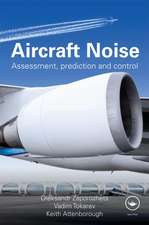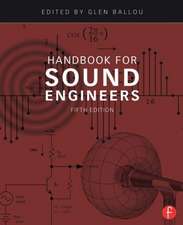Rhythm and Transforms
Autor William Arthur Setharesen Limba Engleză Paperback – 19 sep 2014
| Toate formatele și edițiile | Preț | Express |
|---|---|---|
| Paperback (1) | 892.74 lei 6-8 săpt. | |
| SPRINGER LONDON – 19 sep 2014 | 892.74 lei 6-8 săpt. | |
| Hardback (1) | 898.26 lei 6-8 săpt. | |
| SPRINGER LONDON – 12 iul 2007 | 898.26 lei 6-8 săpt. |
Preț: 892.74 lei
Preț vechi: 1088.70 lei
-18% Nou
Puncte Express: 1339
Preț estimativ în valută:
170.84€ • 177.35$ • 142.46£
170.84€ • 177.35$ • 142.46£
Carte tipărită la comandă
Livrare economică 22 martie-05 aprilie
Preluare comenzi: 021 569.72.76
Specificații
ISBN-13: 9781447160496
ISBN-10: 1447160495
Pagini: 352
Ilustrații: XIII, 336 p.
Dimensiuni: 155 x 235 x 18 mm
Greutate: 0.49 kg
Ediția:2007
Editura: SPRINGER LONDON
Colecția Springer
Locul publicării:London, United Kingdom
ISBN-10: 1447160495
Pagini: 352
Ilustrații: XIII, 336 p.
Dimensiuni: 155 x 235 x 18 mm
Greutate: 0.49 kg
Ediția:2007
Editura: SPRINGER LONDON
Colecția Springer
Locul publicării:London, United Kingdom
Public țintă
ResearchDescriere
People quite naturally identify the rhythmic structure of music as they tap their feet and sway in time with the beat. Underlying such mundane motions is an act of cognition that is not easily reproduced in a computer program or automated by machine. Rhythm and Transforms asks (and answers) the question: How can we build a device that can "tap its foot" along with the music? The result is a tool for detecting and measuring the temporal aspects of a musical performance: the periodicities, the regularities (and irregularities), the beat, the rhythm. The impact of such a "rhythm meter" on music theory and on the design of sound processing electronics such as musical synthesizers, drum machines, and special effects devices is described. The "rhythm meter" provides a concrete basis for a discussion of the relationship between the cognitive processing of temporal information and the mathematical techniques used to describe and understand regularities in data.
Rhythm and Transforms will be of interest to engineers and others interested in the design of audio devices such as musical synthesizers, special effects devices, drum machines, and electronic keyboards. It will be useful to musicians and composers who exploit computer-based tools in the creation and the recording process. It will be of use to arrangers, musicologists, and others interested in musical analysis. Rhythm and Transforms provides a unique approach to working with environmental sounds, and there are clear applications to the synchronization of audio with video (i.e., film scoring). Finally, the target audience also includes those interested in the way the ear works, and how this influences the types of sound patterns we like to listen to.
Rhythm and Transforms will be of interest to engineers and others interested in the design of audio devices such as musical synthesizers, special effects devices, drum machines, and electronic keyboards. It will be useful to musicians and composers who exploit computer-based tools in the creation and the recording process. It will be of use to arrangers, musicologists, and others interested in musical analysis. Rhythm and Transforms provides a unique approach to working with environmental sounds, and there are clear applications to the synchronization of audio with video (i.e., film scoring). Finally, the target audience also includes those interested in the way the ear works, and how this influences the types of sound patterns we like to listen to.
Cuprins
What is Rhythm?Visualizing and Conceptualizing RhythmVariety of Rhythmic ExperienceAuditory PerceptionTransformsAdaptive OscillatorsStatistical ModelsAutomated Rhythm AnalysisBeat-based Signal ProcessingMusical Composition and RecompositionMusical Analysis via Feature ScoresSpeculations, Interpretations, Conclusions
Recenzii
From the reviews:
"Rhythm and Transforms, is a fitting sequel. … There is no doubt that Sethares is a good writer … . His extensive glossary will be a great help to those who are encountering some of the ideas for the first time … . Overall, Rhythm and Transforms is a worthwhile addition to the literature. I’m sure it will find a place … in many personal libraries, as it will in mine." (Thomas D. Rossing, Physics Today, August, 2008)
"This book is about understand the link between the physical stimuli and the subsequent cognitive responses, with the goal of developing algorithms to assist with various applications … . this book contains good material to motivate the interests of students about the ‘importance of mathematics in applications.’ … Your brain will enjoy the entrainment such synchronization performs between electrical impulses and the words in this book." (Robert S. Anderssen, SIAM Review, Vol. 50 (3), 2008)
“This book explores the temporal and rhythmic relationships between sounds and the structure of music, between perceptual aspects of the human auditory system and the sound machines … . This book is useful for engineers and musicians interested in the design of audio devices.” (Manfred Tasche, Zentralblatt MATH, Vol. 1189, 2010)
"Rhythm and Transforms, is a fitting sequel. … There is no doubt that Sethares is a good writer … . His extensive glossary will be a great help to those who are encountering some of the ideas for the first time … . Overall, Rhythm and Transforms is a worthwhile addition to the literature. I’m sure it will find a place … in many personal libraries, as it will in mine." (Thomas D. Rossing, Physics Today, August, 2008)
"This book is about understand the link between the physical stimuli and the subsequent cognitive responses, with the goal of developing algorithms to assist with various applications … . this book contains good material to motivate the interests of students about the ‘importance of mathematics in applications.’ … Your brain will enjoy the entrainment such synchronization performs between electrical impulses and the words in this book." (Robert S. Anderssen, SIAM Review, Vol. 50 (3), 2008)
“This book explores the temporal and rhythmic relationships between sounds and the structure of music, between perceptual aspects of the human auditory system and the sound machines … . This book is useful for engineers and musicians interested in the design of audio devices.” (Manfred Tasche, Zentralblatt MATH, Vol. 1189, 2010)
Notă biografică
William Sethares is a professor at the University of Wisconsin-Madison, where he teaches about electro-acoustics and signal processing. A focus of his research is the relationship between the rhythmic qualities of music – how they are perceived biologically and the qualities of the instruments or machine making the sounds.
Textul de pe ultima copertă
People quite naturally identify the rhythmic structure of music as they tap their feet and sway in time with the beat. Underlying such mundane motions is an act of cognition that is not easily reproduced in a computer program or automated by machine. Rhythm and Transforms asks (and answers) the question: How can we build a device that can "tap its foot" along with the music? The result is a tool for detecting and measuring the temporal aspects of a musical performance: the periodicities, the regularities (and irregularities), the beat, the rhythm. The impact of such a "rhythm meter" on music theory and on the design of sound processing electronics such as musical synthesizers, drum machines, and special effects devices is described. The "rhythm meter" provides a concrete basis for a discussion of the relationship between the cognitive processing of temporal information and the mathematical techniques used to describe and understand regularities in data.
Rhythm and Transforms will be of interest to engineers and others interested in the design of audio devices such as musical synthesizers, special effects devices, drum machines, and electronic keyboards. It will be useful to musicians and composers who exploit computer-based tools in the creation and the recording process. It will be of use to arrangers, musicologists, and others interested in musical analysis. Rhythm and Transforms provides a unique approach to working with environmental sounds, and there are clear applications to the synchronization of audio with video (i.e., film scoring). Finally, the target audience also includes those interested in the way the ear works, and how this influences the types of sound patterns we like to listen to.
Rhythm and Transforms will be of interest to engineers and others interested in the design of audio devices such as musical synthesizers, special effects devices, drum machines, and electronic keyboards. It will be useful to musicians and composers who exploit computer-based tools in the creation and the recording process. It will be of use to arrangers, musicologists, and others interested in musical analysis. Rhythm and Transforms provides a unique approach to working with environmental sounds, and there are clear applications to the synchronization of audio with video (i.e., film scoring). Finally, the target audience also includes those interested in the way the ear works, and how this influences the types of sound patterns we like to listen to.
Caracteristici
Includes supplementary material: sn.pub/extras






